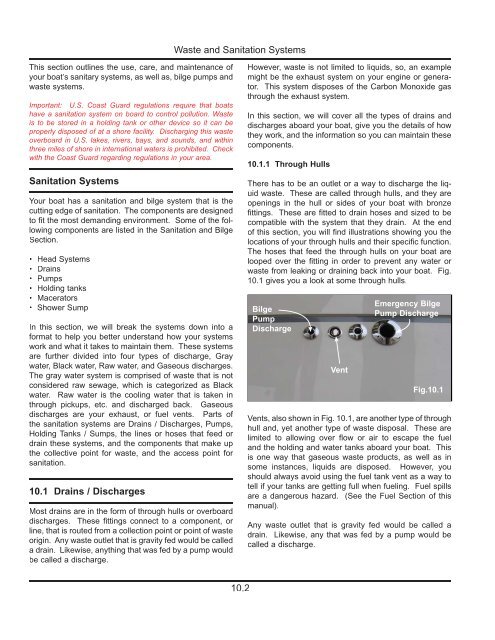36e Operator's Manual 2011.pdf - Marlow-Hunter, LLC
36e Operator's Manual 2011.pdf - Marlow-Hunter, LLC
36e Operator's Manual 2011.pdf - Marlow-Hunter, LLC
Create successful ePaper yourself
Turn your PDF publications into a flip-book with our unique Google optimized e-Paper software.
Waste and Sanitation Systems<br />
This section outlines the use, care, and maintenance of<br />
your boat’s sanitary systems, as well as, bilge pumps and<br />
waste systems.<br />
Important: U.S. Coast Guard regulations require that boats<br />
have a sanitation system on board to control pollution. Waste<br />
is to be stored in a holding tank or other device so it can be<br />
properly disposed of at a shore facility. Discharging this waste<br />
overboard in U.S. lakes, rivers, bays, and sounds, and within<br />
three miles of shore in international waters is prohibited. Check<br />
with the Coast Guard regarding regulations in your area.<br />
Sanitation Systems<br />
Your boat has a sanitation and bilge system that is the<br />
cutting edge of sanitation. The components are designed<br />
to fit the most demanding environment. Some of the following<br />
components are listed in the Sanitation and Bilge<br />
Section.<br />
•<br />
•<br />
•<br />
•<br />
•<br />
•<br />
Head Systems<br />
Drains<br />
Pumps<br />
Holding tanks<br />
Macerators<br />
Shower Sump<br />
In this section, we will break the systems down into a<br />
format to help you better understand how your systems<br />
work and what it takes to maintain them. These systems<br />
are further divided into four types of discharge, Gray<br />
water, Black water, Raw water, and Gaseous discharges.<br />
The gray water system is comprised of waste that is not<br />
considered raw sewage, which is categorized as Black<br />
water. Raw water is the cooling water that is taken in<br />
through pickups, etc. and discharged back. Gaseous<br />
discharges are your exhaust, or fuel vents. Parts of<br />
the sanitation systems are Drains / Discharges, Pumps,<br />
Holding Tanks / Sumps, the lines or hoses that feed or<br />
drain these systems, and the components that make up<br />
the collective point for waste, and the access point for<br />
sanitation.<br />
10.1 Drains / Discharges<br />
Most drains are in the form of through hulls or overboard<br />
discharges. These fittings connect to a component, or<br />
line, that is routed from a collection point or point of waste<br />
origin. Any waste outlet that is gravity fed would be called<br />
a drain. Likewise, anything that was fed by a pump would<br />
be called a discharge.<br />
However, waste is not limited to liquids, so, an example<br />
might be the exhaust system on your engine or generator.<br />
This system disposes of the Carbon Monoxide gas<br />
through the exhaust system.<br />
In this section, we will cover all the types of drains and<br />
discharges aboard your boat, give you the details of how<br />
they work, and the information so you can maintain these<br />
components.<br />
10.1.1 Through Hulls<br />
There has to be an outlet or a way to discharge the liquid<br />
waste. These are called through hulls, and they are<br />
openings in the hull or sides of your boat with bronze<br />
fittings. These are fitted to drain hoses and sized to be<br />
compatible with the system that they drain. At the end<br />
of this section, you will find illustrations showing you the<br />
locations of your through hulls and their specific function.<br />
The hoses that feed the through hulls on your boat are<br />
looped over the fitting in order to prevent any water or<br />
waste from leaking or draining back into your boat. Fig.<br />
10.1 gives you a look at some through hulls.<br />
Bilge<br />
Pump<br />
Discharge<br />
Vent<br />
Emergency Bilge<br />
Pump Discharge<br />
Fig.10.1<br />
Vents, also shown in Fig. 10.1, are another type of through<br />
hull and, yet another type of waste disposal. These are<br />
limited to allowing over flow or air to escape the fuel<br />
and the holding and water tanks aboard your boat. This<br />
is one way that gaseous waste products, as well as in<br />
some instances, liquids are disposed. However, you<br />
should always avoid using the fuel tank vent as a way to<br />
tell if your tanks are getting full when fueling. Fuel spills<br />
are a dangerous hazard. (See the Fuel Section of this<br />
manual).<br />
Any waste outlet that is gravity fed would be called a<br />
drain. Likewise, any that was fed by a pump would be<br />
called a discharge.<br />
10.2

















